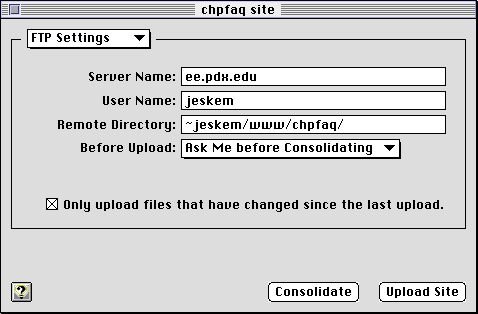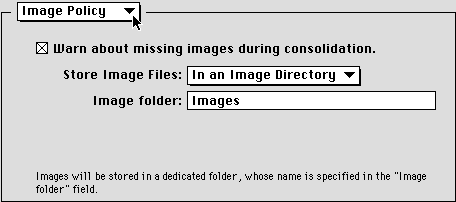Site File Introduction and Questions Back to Main FAQ

Join the
Mac
OS 8 Web Campaign!
|
Site File Introduction and Questions Back to Main FAQ |
|
2. How do I set up a site file?
3. I am having problems uploading my site. What do I do?
1. Question: What are site files?
Answer: Site files are a new feature in CHP 2.0. When you develop a site with CHP, you can create a site file in the root directory of your site. It stores information about the site, such as the name of the server where you keep your site, the directory on the server where your site is stored, and when you last uploaded your site. The site file has the capability to "consolidate" your site, and maintain a mirror image on your server.
Basically, you have a site, you make a site file, you click the "Upload Site" button in your site file, and your site is on the web. Make some changes, save, click the "Upload Site" button, and your changes are made to your site on the web.
2. Question: How do I set up a site file?
Answer: First you have to have a site, or the beginning of one. As an example, I will use this CHP FAQ site. Its URL (Universal Resource Locator) is http://www.ee.pdx.edu/~jeskem/chpfaq/. This means that it is stored on the web server at www.ee.pdx.edu, and from the web server's point of view, the site main directory is located in ~jeskem/chpfaq/.
On my hard drive, I have a folder named chpfaq, and inside it are the files and sub-folders of the site. So first, I will put a site file in the main folder/directory of my site.
![]() Open
the "File" menu and choose "Site" from the "New" sub-menu. An
"Untitled" Site file will open. Choose "Save..." from the "File"
menu, and navigate to the main folder of your site on your hard drive
and click the "Save" button.
Open
the "File" menu and choose "Site" from the "New" sub-menu. An
"Untitled" Site file will open. Choose "Save..." from the "File"
menu, and navigate to the main folder of your site on your hard drive
and click the "Save" button.
Now I'll go through the settings in the site file.

Server Name
The first field asks for the name of the server where the files should be transfered. In the case of the CHP FAQ, I have dropped the www from the front of the address because of the setup of the network where my site is. Other service providers may have different addresses for uploading files as well. A local service provider here in Portland, Oregon, Teleport, has its users upload files to ftp.teleport.com, while the web server is at www.teleport.com. (For those who use fetch to upload files, use the same address).
User Name
Your user name on the server that hosts your web site.
Remote Directory
The directory on the web server that where the site is located. Make sure to use the actual path to your base directory, not the URL's path. For example, the path in the URL for the CHP FAQ is ~jeskem/chpfaq/ , but the actual location of the CHP FAQ on the server is ~jeskem/public_html/chpfaq (I have directory www linked to public_html), so I must use that path (~jeskem/www/chpfaq/).
WARNING! If you do not use the actual path but instead the URL's path, your web site will probably be saved in the wrong place, and it will be a hassle to have to delete it.
Remember to include the main folder/directory of your site in the path, as CHP will not create a folder on the web server to match the your main folder on your local hard drive.
If CHP finds that any of the directories in your path or in your site do not exist, it will create them for you on the server.
Before Upload
This pop-up menu gives you three options: Always Consolidate, Never Consolidate, and Ask Me before Consolidating. Consolidation means that CHP goes through all the linked images in your html files, copies them to the same directory as your html files, and changes all the image links appropriately. This feature is great for those who have used a lot of clip-art from the included collections, or from other places on their computer. However, many people, including myself, like to both have images in seperate folders, and share images between many pages which may not be in the same folder. In this case, you can select Never Consolidate, or Ask Me. As long as your image files are somewhere within the hierarchy of your site, they will be uploaded.
Only upload files which ...
After the first time you upload your site, you should check this option; it saves you time. In order for this option to be effective, make sure to save changes to your site file when you close it.

These options are pretty straight-forward. My recommendation is to use a images folder because it keeps things more tidy. Note that these settings only apply to Consolidation of your site. If you choose not to consolidate, these settings don't matter.
This is the simplest step: Click the Upload Site button, type in your password, and wait.
Always check to make sure that your site works correctly on-line by going to a different machine and viewing it in a browser or two. (You can also use the same computer, but you run the risk of not discovering links that lead to files on your own hard drive.)
The last section of your site file is Statistics. Clicking the Refresh Now button will give you the latest information about your site: where it is on your hard disk, how many HTML pages it has, and the total amount of space it uses.
Final Note
Remember that a CHP site file will upload all the documents within its directory snd sub-directories, not just html, gif, and jpeg files, so keep any private files out of your site's folder. TOP
3. Question: I am having problems uploading my site. What do I do?
Because the Site upload is a complex process, there are many factors which may cause an error. Below is a list of Symptoms and Solutions
|
When you begin to upload the site, a dialog appears saying you do not have permission. |
|
|
After making corrections to a site and selecting the "Only upload files changed since last upload" option in my site file, CHP still uploads all my files to the server. |
|
|
After about 60 files are uploaded to the server, an error message appears about Server Passive Mode. |
|
|
After I upload using the site file feature, there are problems with my site. Image maps don't work, spaces between some words are missing, and other formating doesn't completely work. |
|
Created by: Marcin Jeske (jeskem@ee.pdx.edu)
![]()
![]()